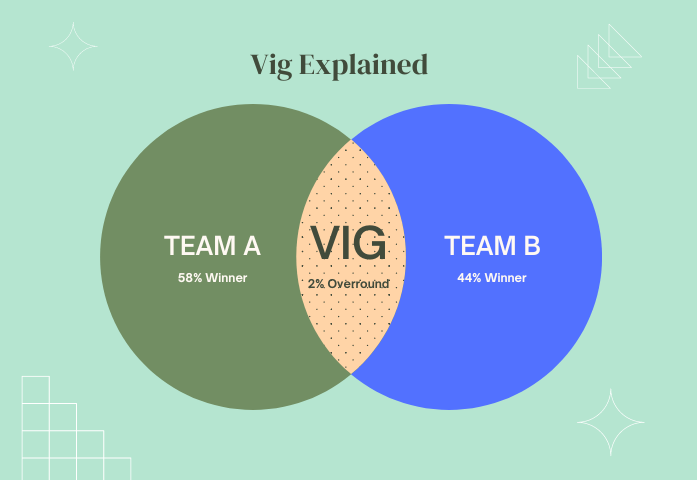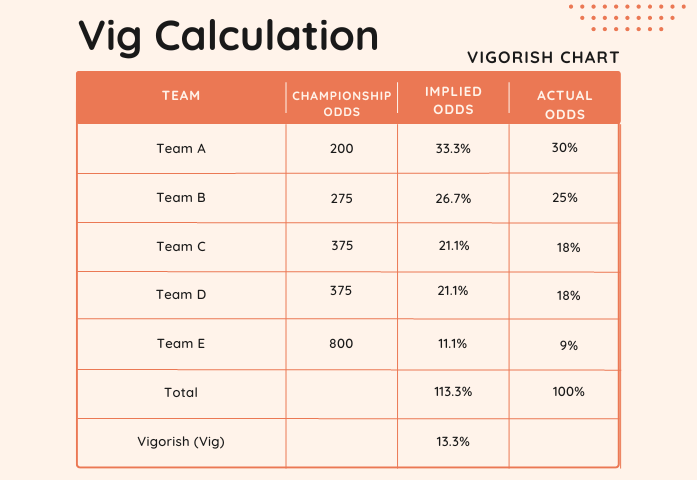March 10, 2023
Understanding the Vig
Sports betting can be a lucrative endeavor, but it is important to know the terminology and concepts involved. Thankfully, understanding betting lines and odds isn’t reserved for just experienced bettors. If you want to step your betting knowledge up and increase your sports bet wins, it starts with knowing exactly what it is you are betting on.
One important term to understand is the “vig,” or commission charged by bookmakers. Before placing more bets, make sure you know how much the sportsbook takes from your bet (i.e. the vig).
- The vig is a commission that bookmakers charge on a wager to make a profit and is also known as “vigorish,” “cut,” “edge,” “juice,” or “take.”
- The bookmaker adjusts the odds slightly downward and creates an overround to include the vig in the betting line, and the odds given by the bookmaker are not an exact representation of the expected outcome.
- The vig is always included in the odds of a sporting event and is set on both sides of the event, and the rate varies depending on the bookmaker’s chosen overround, with a standard vig rate of 4.76% built-in for an over-under bet with -110 odds expressed on both sides.
Interested in doing some sports betting? You’ll first need to know about the vig. Vig betting requires first understanding what the vig is, how to calculate vig, and knowing the actual probabilities and impact of vig in sports betting. Thankfully, we have broken down the vig at length in this guide to help every gambler understand the vig and how it works.
When you’re playing a traditional casino game like blackjack or slots, you know that the casino will always have a house edge. That’s how they make their money, even if some players manage to break the bank now and again. It’s even where the phrase “the house always wins” comes from.
However, did you know the “house edge” also exists in sports betting? Well, it’s not technically an edge, but a commission rather. You see, bookmakers charge a fee so they can cover some of the risks that come with betting. This edge or commission, is also known as the “vigorish” or “vig.”
Keep reading to learn more about how the vigorish (vig) works and what this number can mean for you when placing your wagers.
Vig Betting FAQs
Below are a few of the most common questions people have about the vig or juice when betting.
- Does the point spread affect how much vig the sportsbook sets?
- Is the vig set by the sportsbook operator or sportsbook provider?
- What is the actual vig and does it apply to both the losing and winning bettor?
- Is the vig part of sportsbooks’ risk-free bets or bonus bets?
- Do most sportsbooks explain their vig directly to bettors?
Other Names for the Vigorish
The word “vigorish” is some Yiddish slang, originating from the Russian word for “winnings.” Not everyone speaks Yiddish, but plenty of people know the term’s abbreviated name: the vig.
You’ll also see other nicknames for this margin in sports betting, like:
- Cut
- Edge
- Juice
- Take
These all describe the commission that bookmakers take-off of a wager to ensure that they can make a profit, even if the occasional bettor hits 20-to-1 odds.
What the Vig Actually Is
The odds you see reflected by the sportsbook aren’t the true odds of a potential outcome. If the implied probabilities of all outcomes totaled 100%, then the bookmaker wouldn’t be able to make any profit. So the bookmaker does all the work of calculating the true odds, and then they’ll adjust the odds downward a bit before publishing them for bettors to gamble on.

The bookmakers accomplish this by creating what’s called an “overround.” Let’s say that a bookmaker has set their odds of Team A having a 58% chance of winning and Team B as having a 44% chance of winning. If we add those up, the total implied probability is 102%. This percentage over 100% (2% in this case) is called the overround. Adjusting this overround allows bookmakers the opportunity to raise or lower the vig they charge on a particular betting line.
Thus, the odds as given by the bookmaker aren’t an exact representation of what they expect will actually happen. The vig gets included in the betting line as the overround.
Now, you won’t always end up actually paying the vig. While yes, you do have to put all of your money up at the start, the bookmaker will give you back what you’d bet plus any profits if you win your wager. If you’d bet $110 on a particular betting line and lose, you’ll be out your $110. But if you win that $110 wager, you would get back your $110 plus whatever winnings you’d made on top of that.
This is why some people say that bookmakers will take their vig on only losing bets — it’s a simplified way of looking at how the vig plays into your wagers and potential profits.
What the Vig Might Look Like at Your Sportsbook
The vig will always be included in the odds of whichever sporting event you’re betting on. The vig will also be set on both sides of the event. The risk would be too high for a bookmaker to try to make their profits on just one potential outcome — this way, no matter which way the game goes, they have a shot at making their commission.
You might see it reflected in dollar amounts or as part of the percentage. It’s not always the same, static percentage for every bet, either. The vig is a dynamic surcharge based on the bookmaker’s chosen overround.
As bets start to come in for a particular event, the odds will actually start to shift. The bookmaker has to change their odds in order to balance out the dynamic potential payout on either side. If more people are betting on one particular outcome, then the bookmaker needs to adjust the odds so that bettors find the other outcome appealing enough to bet on it instead. The bookmaker will take bets in optimal proportions to ensure they can pay out and still profit, no matter what outcome the event has.
Additionally, the vig may vary based on the popularity of the event and the level of competition among sportsbooks. For instance, if multiple sportsbooks are offering odds for the same event, they may try to undercut each other’s vig to attract more customers. This is particularly obvious around large sporting events like the Super Bowl or March Madness where sportsbooks see a huge influx in new bettors.
Therefore, it’s important to understand the vig and shop around for the best odds and lowest vig to maximize your winnings in the long run.
Over-Under Bets
Also called totals, these types of bets involve wagering on whether the final point total for a game is over or under a predetermined number. These betting lines are nearly always set at equal odds (meaning that you could potentially win the same amount irrespective of which way you bet). This also means that the vig on these lines is “standardized” and most likely the same across all such events.
In an over-under bet with -110 odds expressed on both sides, a 4.76% vig rate is built in. Other sportsbooks might offer lower or higher lines, but this “standard vig” is a solid way to compare the general rates charged at different sportsbooks. Here’s a standard vig chart for easy reference:
| Over-Under/Totals Line (equal odds on both sides) | Vigorish (%) |
| -105 | 2.44% |
| -110 | 4.76% |
| -115 | 6.98% |
| -120 | 9.09% |
| -125 | 11.11% |
Point Spreads
You can easily see the vig presented in point spreads. Like most bets, point spreads do not offer even odds. You might see a spread bet for a football game like this:
- Seattle Seahawks: -3.5 -110
- Carolina Panthers: +3.5 -110
The -110 next to each team indicates that you’ll have to wager $110 for every $100 you want to win. If you win, then you get your $110 back plus $100. You don’t make back a second $110 because that extra $10 represents the bookmaker’s vig.
Removing the Vig To More Clearly See Likely Outcomes
If you want to see a more accurate picture of what outcome the bookmakers actually expect, you need to remove the vig from the odds as they’re presented.
The odds as they’re given factor in profitability on top of likely outcomes, so removing the vig from the betting line gives you a more accurate picture of the truer probabilities the oddsmakers have assigned to each potential outcome. This is known as the “actual probability,” rather than the “implied probability” that oddsmakers share with bettors.
If you remove the vig, you can more accurately compare the fees between different sportsbooks and also just see how much a particular sportsbook has inflated a betting line’s price.
To remove the vig, you need to follow three steps:
- Calculate the implied probabilities of all outcomes.
- Use the total implied probability to find the vig as a percentage.
- Calculate the actual probability by removing the overround to bring the total implied probabilities to 100%.

Calculate the Implied Probabilities
When looking at moneyline odds, you have to think of the equation as risk ÷ return.
If you’re given these moneyline odds:
- Boston Celtics – 300
- Phoenix Suns: +225
You have to calculate the implied probability of each outcome by dividing how much money you’d have to wager (the risk) by how much you could possibly get back if you win (the return). Remember that moneyline odds show you two things:
- Underdogs (+): How much you could win for every $100 staked
- Favorites: (-): How much you need to stake in order to win $100
So to calculate the implied probabilities for each:
- Boston Celtics: Bet $300 Win $100 Return $400
- 300 / 400 = 0.75 (75%)
- Phoenix Suns: Bet $100 Win $225 Return $325
- 100 / 325 = 0.30 (30%)
You add the two implied probabilities together: 0.75 + 0.30 = 1.05 (105%)
So, the overround is 105%.
Calculate the Vig as a Percentage
Because the vig is technically the associated percentage amount that the sportsbook will profit on the betting line, you can use the overround to calculate the vig’s percentage like so:
Vig = 1 – 1 / overround x 100
With the above example of a 105% overround:
1 – (1 / 105) x 100 = 0.476 (4.76%)
Calculate the Actual Probability
Here’s your equation to remove the overround in order to find the actual probability:
team implied probability / total implied probability = actual probability
- Boston Celtics: 75 / 105 = 0.71 (71%)
- Phoenix Suns: 30 / 105 = 0.29 (29%)
This means that the Celtics’ actual probability of winning is 71%, while the Suns’ actual probability is 29%. To make sure you’ve done your calculations correctly, add them up. They should equal 100%:
71% + 29% = 100%
Going through this process helps you to know what the sportsbook actually thinks the outcome of the game will be. You also can better see which bets are just simply overpriced.
You should ultimately remember that you’re still going to be wagering on the odds as the sportsbook offers them, though. This is simply knowledge to help you determine your best options.
The Bottom Line
If you ever feel like having a vig be part of the sports-betting process isn’t fair, remember that it’s effectively the same as a casino having its house edge. If you successfully calculate how much any given sportsbook’s vigorish is, you can more easily shop around.
Look around at various online sportsbooks for the highest payout on a $100 wager or for the least amount risked. While you’re still going to pay the bookmaker’s commission, you can get more for the same size bet than you would at a different site.
So, you can take this information to scout around for the best vig and try to get the best return on your wagers.
Additionally, understanding the vig can also help you make better betting decisions. It allows you to analyze the odds and determine if the potential payout is worth the risk, and whether you should place a bet at all. It’s important to remember that the vig is an inevitable part of sports betting, and while it may seem like a small percentage, it can add up over time. By being aware of it and doing your research, you can make more informed decisions and potentially increase your chances of success in the long run.
Sports Betting Guides
Want to learn more about sports betting? Consider diving into one of our guides to sports betting.
-
Sports Betting Guides
Our Sports Betting Top-List.
-
Sports Beting Odds
Learn how to read sports betting odds.
-
Legalities of Sports Betting
What are the laws around sports betting?
-
Types of Sports Bets
What are the different types of sports bets?
-
Sports Betting Mistakes
Avoid these common sports betting errors.






